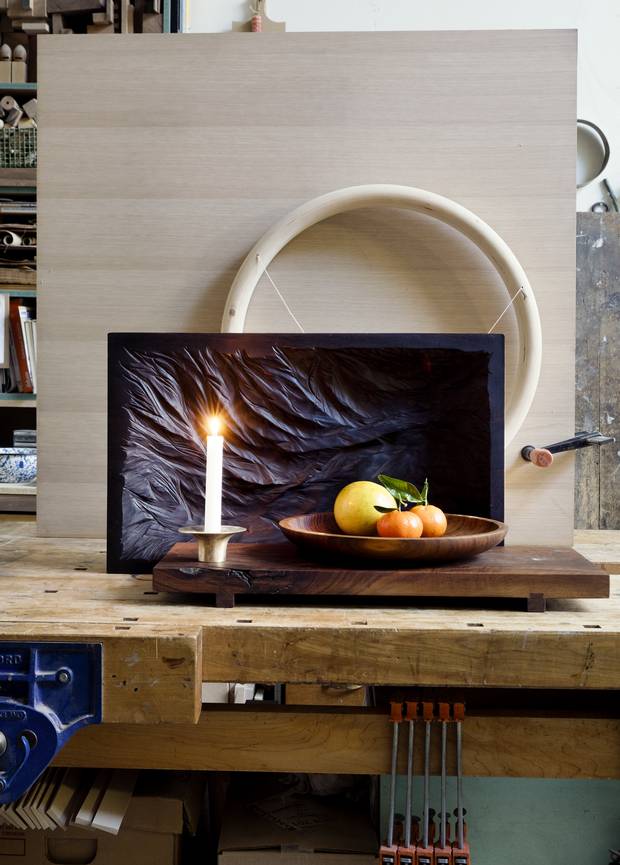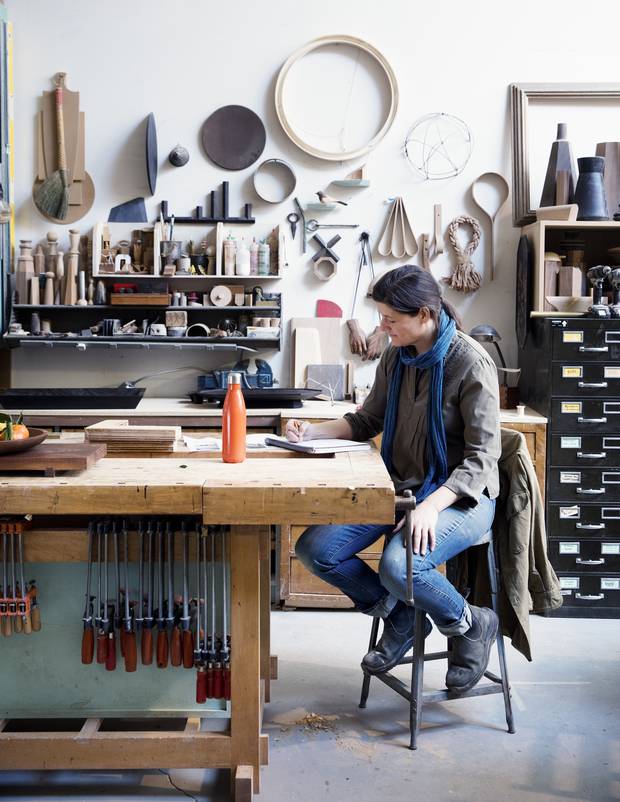Tucked away in an industrial warehouse on Sterling Avenue, a creative hub in Toronto's west end, Heidi Earnshaw's skylit studio is filled from floor to ceiling with pieces of walnut and quartersawn white oak in all shapes and sizes. Piles of lumber and finished chairs are stacked alongside various works in progress, and Earnshaw's seven-month-old German shepherd/border collie/ husky mix, Lou, rests on the floor next to a workbench. The sound of a whirring blade and the smell of fresh sawdust fill the air, and there's not a single computer in the room, just a selection of tools that I vaguely recognize from high school shop class. "I bought my first table saw from a high school," Earnshaw says when I mention this.
It's here that Earnshaw creates her clean-lined, modern-yet-traditional pieces: Japanese- and Scandinavian-influenced credenzas, benches and cabinets. She's best known for her meticulously finished dressers (prices start at $5,000) and recently designed an executive desk for the offices at the Ismaili Centre in Toronto, part of the Aga Khan Park. A set of credenzas she created for Canada House, the Canadian High Commission in London, sit alongside artwork by Emily Carr and Jeff Wall. Now, Earnshaw is about to broaden her reach through a project with Ethnicraft, a Belgian manufacturer that will produce a collection of side and coffee tables to be sold in 50 markets around the world.
That anyone can carve out a successful career as a woodworker in 2016 might seem quaint, and going into this line of work was not always Earnshaw's plan. While studying fine art at the University of Toronto, she gravitated toward sculpture, which led to a side gig in carpentry to help pay the bills. After a stint producing custom cabinetry at the Toronto studio Gibson Greenwood, Earnshaw moved on to the practice of landscape architect Janet Rosenberg, who is known for creating the master plan for Rideau Hall in Ottawa and the revitalization of the Martin Goodman Trail along Toronto's waterfront.

Earnshaw has begun to broaden her focus to include smaller objects like carved trays and cast brass candle holders.
But it's Earnshaw's fine art background that informs her furniture making, and is the reason why most everything is done manually in her studio, despite the fact that many of her peers rely on computers. "I still do all my technical drawings by hand, which is pretty unheard of these days. It's pretty archaic," she says. "I find putting pencil to paper is a really integral part of putting together my thought process."
"Her sensibility and attention to detail are what set her apart from others," says Arriz Hassam, the Toronto-based interior designer behind arriz+co, who brought Earnshaw on to the Aga Khan project. "Her work is subtle, focused and celebrates the beauty of simplicity. It is indeed a difficult thing to achieve, and she has the right touch." Today, the bulk of her work comes from commissions, a thriving business she's built mostly by word of mouth. "People come to the studio and we hash out ideas," she says. "Some are involved in drawing with me, and they have lots of feedback. Others are more hands-off."
That collaborative approach resonated with Jodi Ballett, a client who encountered Earnshaw's work six years ago at the Interior Design Show in Toronto. Ballett commissioned her first Earnshaw piece when her elderly father was downsizing from a house to a condo and needed a new home for his 65-year-old record collection of more than 700 albums. She and Earnshaw worked together on a set of two abutting credenzas, each four feet long, to house his 78s. "It's evident that Heidi is a real artisan and talented woodworker and, as it turns out, it's also been a lot of fun working with her," she says.

"She always knows exactly what I'm looking for," says Natalie Herbert, an interior designer who has commissioned multiple pieces for her family homes in Toronto's Rosedale and Beach neighbourhoods. "My favourite piece she built is a gorgeous dresser in walnut. It looks like a modern version of a piece from another time, and will be passed down to my children and hopefully my children's children."
Imbuing her pieces with an heirloom-worthy sense of meaning attracts clients who share Earnshaw's ethos. "There's a different demographic that's saving to buy one piece and prioritizing that over other places that they might spend their money," she says. "People are buying smaller houses and filling them with higher quality, more meaningful things. It's important to them. When they sit around their table, they can say, 'It was made right over here. This is how it happened. We got to choose the wood.'"
That wood is always sourced from North America, an eco-conscious shift away from the exotic trees of Africa and South America where deforestation and unsafe labour practices are real issues. "Woods go in and out of favour, and quality is a whole other story in and of itself," she says. "It's an amazing, renewable resource, but the trees are being harvested a lot sooner now. The quality of the wood is changing."

Her next creative challenge is moving away from full-size furniture to experiment with smaller items like candlestick holders, lighting and bowls that incorporate cast brass elements. No matter where her tools take her, quality is always of paramount importance and she sees parallels between a consumer's evolving relationship with both clothing and furniture.
"How many people these days know how to mend a sock or sew a button on a coat?" she asks. "The zipper goes and all of a sudden you throw it out. It's not that we don't have those skills – those skills are easy enough to develop. We don't have those values anymore.
"What I'm hoping is that, with what's going on in material culture these days, we're going back to that a little bit more. Even the idea of knowing what objects you have in your house, why you have them and where they came from. Our lives are so filled with visual clutter."
To watch Heidi Earnshaw at work in her Toronto studio, download the free Globe Style Advisor app.
